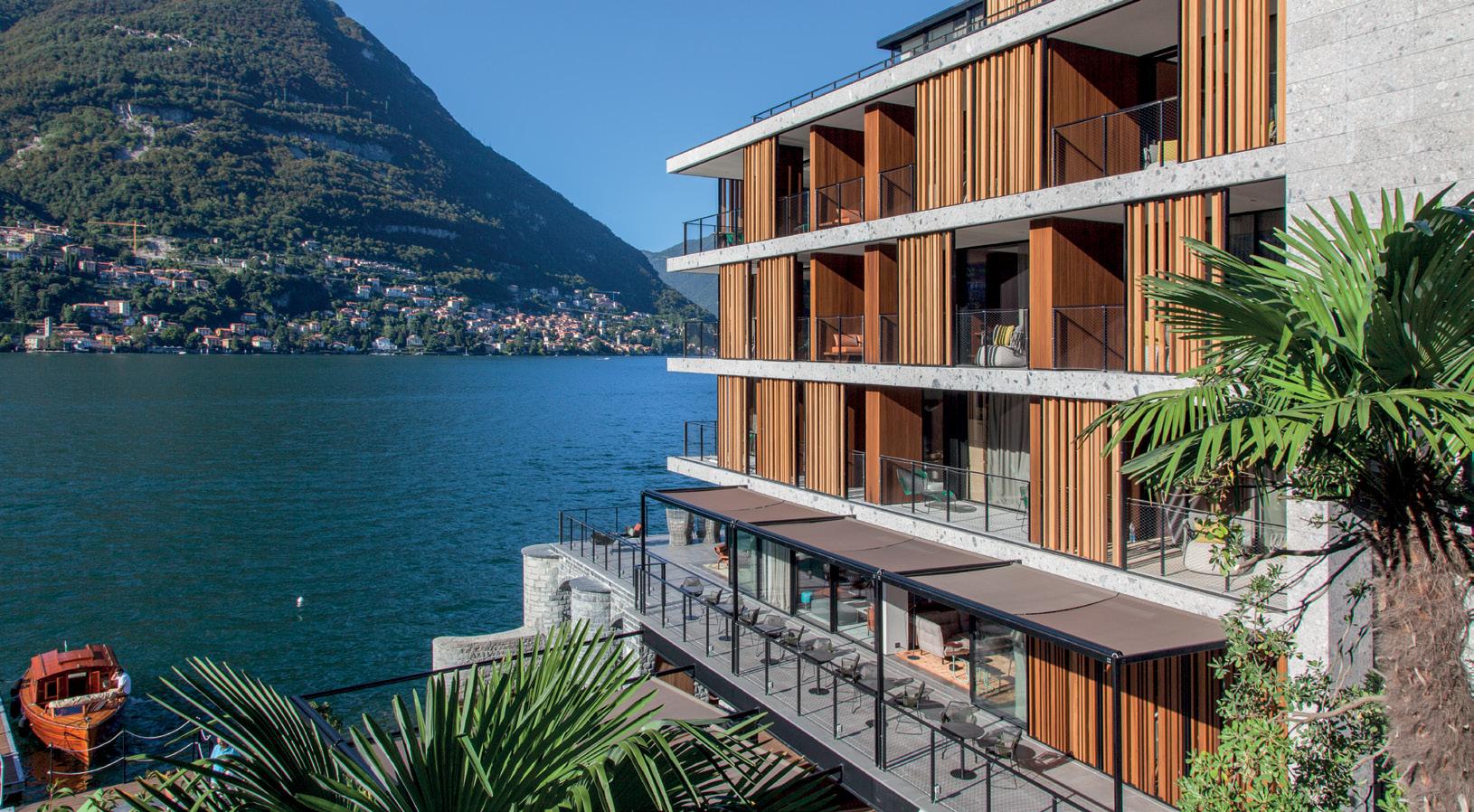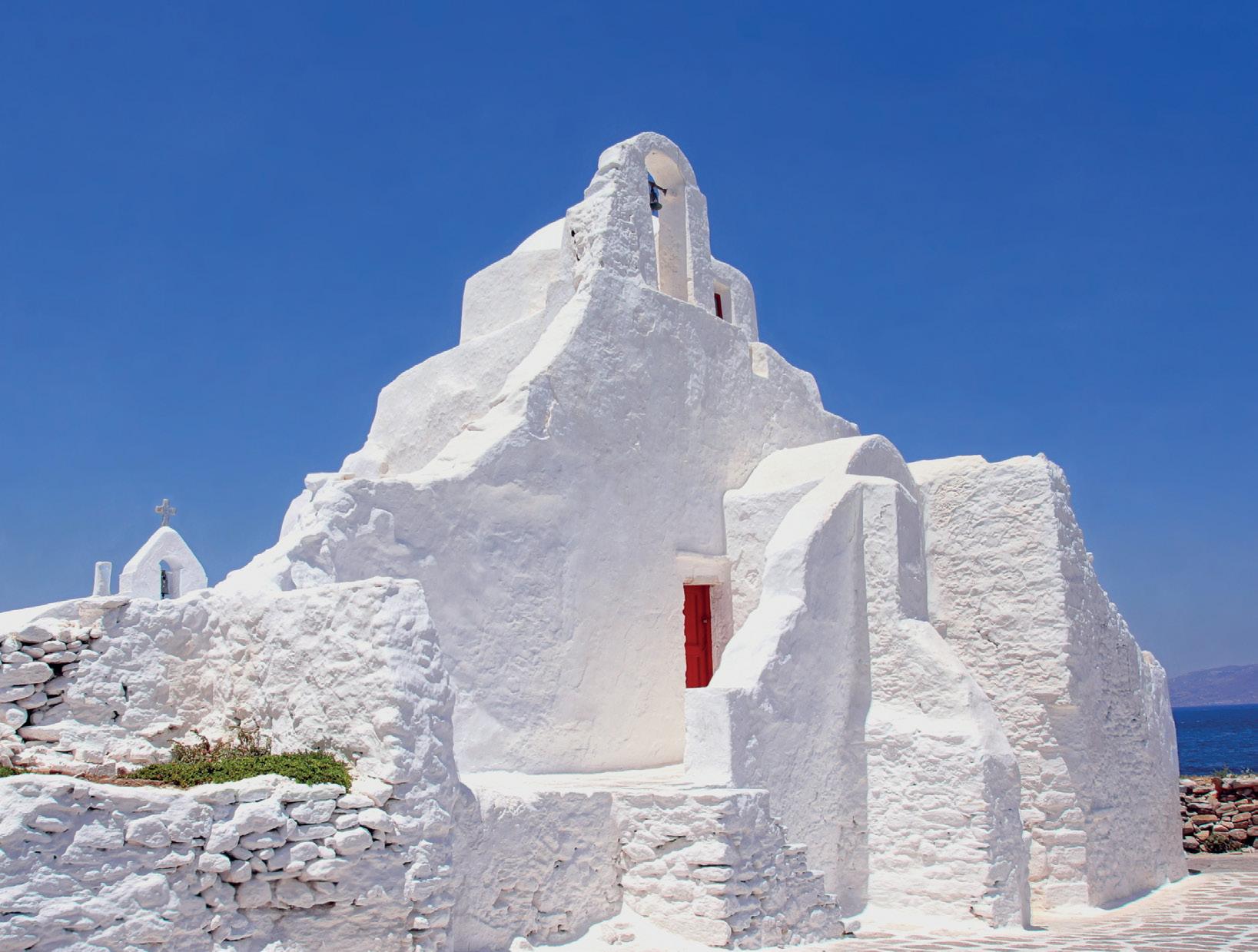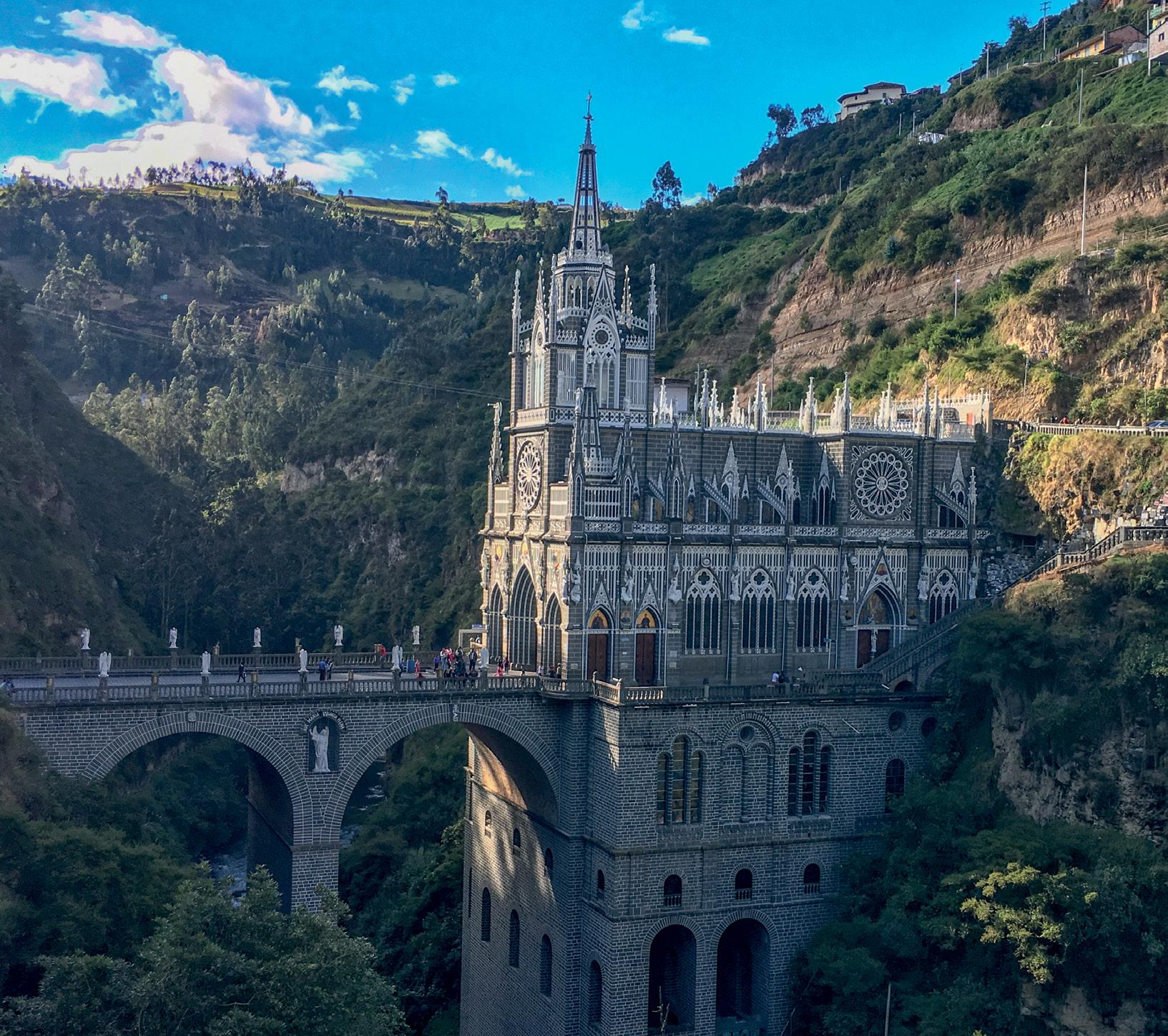
9 minute read
Hospedagem às beiras do Lago Como
from Ahead mag
SERENIDADE À ITALIANA
SERENITY ITALIAN STYLE
Advertisement
por/by Edison Veiga
Conforto, luxo e modernidade à beira de um lago italiano com vista para os Alpes Comfort, luxury and modernity on the shore of an Italian lake with a view to the Alps
Às margens do Lago de Como, em Lombardia, na Itália, e com a beleza dos Alpes no horizonte, o Il Sereno é daqueles poucos hotéis que (realmente) fazem jus à expressão “intimista e exclusivo”. São apenas 30 suítes, todas com sacada privativa e vista para a imensa lagoa azul. Com diárias que variam de 750 a 4 mil euros, o serviço esmerado faz valer cada centavo: da arrumação de quarto duas vezes por dia ao espumante com petiscos deixados nas suítes ao entardecer.
Apreciar é a palavra. E relaxar. Hospedar-se ali é ser tomado pelo verdadeiro dolce far niente que os italianos entendem tão bem: confortos e mimos dão aquela vontade de nem sair — mas uma caminhada pelas ruas de Torno, a cidadela onde ele está instalado, também vale a pena.
Inaugurado em 2016, o hotel tem uma arquitetura contemporânea que contrasta com o estilo antigo das construções históricas da cidadezinha ou com o neoclássico vigente no restante da hotelaria chique da região. Tem piscina de borda infinita, ancoradouro particular para lanchas, spa completo e academia.
O salão onde é servido café da manhã abriga o restaurante Berton Al Lago. Sob o comando do chef Raffaele Lenzi, é dono de uma estrela Michelin e oferece almoço e jantar (sob reserva, também para não hóspedes) praticamente ao nível d´água — o local, originalmente, era uma garagem de barcos.
// On the shore of Lake Como, in Lombardy, Italy, and with the beauty of the Alps in the horizon, Il Sereno is one of those few hotels that (really) live up to the expression “intimate and exclusive”. It has only 30 suites, all of them with a private balcony and a view to the immense blue lake. With daily rates ranging from 750 to four thousand euros, the flawless service makes it worth every cent: from room cleaning twice a day to the sparkling wine with tidbits left at the suites in late afternoon.
Enjoying is the word. And relaxing. Staying there is like being possessed by the true dolce far niente that Italians understand so well: comfort and amenities will make guests want to stay in all the time – but a walk through the streets of Torno, the small village where the hotel is located, is also worth it.
Inaugurated in 2016, the hotel has contemporary architecture that contrasts with the antique style of the village’s historical constructions or with the neoclassic present in the rest of the region’s chic hotels. It has an infinity pool, private dock for motorboats, spa and gym.
The room where breakfast is served houses restaurant Berton Al Lago. Helmed by Chef Raffaele Lenzi, it boasts one Michelin star and offers lunch and dinner (reservation required, also for nonguests) practically at water level – the place, originally, was a boathouse.

Como chegar
O hotel fica a cerca de 50 minutos de carro de Milão. Os aeroportos que servem à cidade, portanto, são a melhor maneira de chegar à região do lago.
Agito logo ali
A cidade de Como, a mais movimentada da orla do lago, fica a 6 quilômetros do Il Sereno. Vale a pena incluir no roteiro algumas horas para conhecê-la.
Design moderno
O hotel é assinado pela designer espanhola Patricia Urquiola. O estilo contemporâneo homenageia a efervescência arquitetônica e cultural milanesa.

//How to get there The hotel is located at a 50-minute car ride from Milan. The airports of the region, therefore, are the best way of getting to the lake. Nearby Hubbub The city of Como, the busiest on the lakeshore, is about 4 miles from Il Sereno. Guests should reserve a few hours to visit it. Modern design The hotel is signed by Spanish designer Patricia Urquiola. The contemporary style pays homage to Milanese architectural and cultural effervescence.
Diárias a partir de 435 euros // Daily rates from 435 euros

Pointe Milou, F-97133 – St Barth hotelchristopher.com
SANTA ARQUITETURA
HOLY ARCHITECTURE
Igrejas monumentais, repletas de torres, vitrais e altares, e capelas singelas, que se confundem com o entorno, nos aproximam do divino em meio à natureza ou em grandes cidades Monumental churches filled with towers, stained glass windows and altars, and modest chapels that blend in with the surroundings, bring us closer to divinity, amidst nature or in big cities

por/by Olga Kovalenko

CATEDRAL DO SANGUE DERRAMADO (RÚSSIA)
O templo foi construído em São Petersburgo, em 1883, pelo arquiteto Alfred Parland no lugar da ferida mortal no Imperador Alexandre II. A catedral idealizada na arquitetura moscovita dos séculos 16 e 17 tem nove cúpulas e pode abrigar 1600 pessoas. Durante a União Soviética, foi fechada e havia rumores de que o governo queria implodi-la. Reabriu em 1997 como um museu com uma coleção impressionante de ícones em mosaico.
+ spas.spb.ru
CHURCH OF THE SAVIOR ON SPILLED BLOOD (RUSSIA) // The temple was built in Saint Petersburg in 1883 by architect Alfred Parland, on the site where Emperor Alexander II was fatally wounded. The cathedral based on the Muscovite architecture of the 16th and 17th centuries has nine cupolas and may house 1600 people. During the time of the Soviet Union, it was closed and there were rumors that the Government wanted to implode it. It reopened in 1997 as a museum, with an impressive collection of icons in mosaic.
+ city.himeji.lg.jp


SAGRADA FAMÍLIA (ESPANHA)
A magnífica catedral (ainda) inacabada de Antoni Gaudí é o maior símbolo de Barcelona e da arquitetura modernista catalã. A construção começou em 1882 e quando o artista catalão faleceu, em 1926, apenas um quarto da estrutura havia sido concluída. Décadas se passaram e, mesmo ainda em obras, o templo recebe cerca de 5 milhões de visitantes por ano. A última previsão promete a conclusão da igreja para 2026.
SAGRADA FAMÍLIA (SPAIN) // Antoni Gaudí’s (still) unfinished, magnificent cathedral is the biggest icon of Barcelona and of Modernist Catalan architecture. Construction started in 1882 and when the Catalan artist died, in 1926, only one-fourth of the structure had been concluded. Decades have passed and, even though it is still under construction, the temple welcomes 5 million visitors per year. The last forecast promises conclusion of the works by 2026.
IGREJA PANADIA PARAPORTIANI (GRÉCIA)
Moradores da ilha de Mykonos afirmam que existem exatamente 365 igrejas em seu território – uma para cada dia do ano, e Paraportiani é considerada a mais bonita. Sua construção remonta aos séculos 15 e 17 e a estrutura branca como a neve parece particularmente impressionante com o mar e o céu azul ao fundo. O templo é composto por quatro igrejas construídas em pedra. A ausência de decorações externas confere-lhe certa severidade e santidade especial.
+ visitcalifornia.com
PANADIA PARAPORTIANI CHURCH (GREECE) // Inhabitants of the island of Mykonos state that there are exactly 365 churches in its territory – one for each day of the year, and Paraportiani is considered the prettiest. Its construction dates back to the 15th and 17th centuries and the structure, white as snow, looks particularly impressive matched by the sea and the blue sky in the background. The temple is made up of four churches built in stone. The absence of external décor bestows upon it a certain severity and special sanctity.



Considerada a obra-prima do arquiteto Oscar Niemeyer no Conjunto Arquitetônico da Pampulha, às margens da Lagoa da Pampulha, em Belo Horizonte (MG). A Igreja foi inaugurada em 1943, mas permaneceu 14 anos proibida ao culto – as autoridades eclesiásticas da época não permitiram a consagração da igreja devido a sua forma incomum e a um painel de Cândido Portinari que traz um cachorro junto a São Francisco de Assis. Os jardins da igreja são assinados por Burle Marx, o mesmo paisagista de Brasília.
SÃO FRANCISCO DE ASSIS DA PAMPULHA CHURCH (BRAZIL) // Considered the masterpiece of architect Oscar Niemeyer in the Pampulha Modern Ensemble, on the shores of Pampulha Lake, in Belo Horizonte (state of Minas Gerais). The church was inaugurated in 1943, but worship was prohibited for 14 years – the ecclesiastical authorities at the time would not allow the consecration of the church due to its uncommon format and a panel by painter Cândido Portinari that depicts a dog next to Saint Francis of Assisi. The church gardens are signed by Burle Marx, the same landscape artist whose work adorns Brasília.
IGREJA DO SANTO SEPULCRO (ISRAEL)
Um dos maiores e mais belos santuários do mundo cristão foi construído a partir do ano 335, de acordo com a lenda, exatamente no local onde Jesus Cristo foi sepultado após sua crucificação, em Jerusalém. O templo é um grande complexo que contém relíquias como a Pedra da Confirmação, a Caverna do Santo Sepulcro, o leito de sepultamento e o rochedo Gólgota, além de estar dividido em vários recintos que contemplam as igrejas católica, ortodoxa grega, armênia, síria, copta e etíope.
CHURCH OF THE HOLY SEPULCHER (ISRAEL) One of the biggest and most beautiful sanctuaries of the Christian world was built starting in the year 335, according to legend, exactly on the place where Jesus Christ was buried after his crucifixion in Jerusalem. The temple is a big compound that contains relics like the Stone of Anointing, the Cave of the Holy Sepulcher, the burial site and the rock Golgotha, besides being divided in many enclosures contemplating the Catholic, Greek Orthodox, Armenian, Syrian, Coptic and Ethiopian churches.


SANTUÁRIO DE LAS LAJAS (COLÔMBIA)
A igreja em estilo gótico localizada a 7 km de Ipiales, no sul do país, é um dos principais lugares de peregrinação católica da Colômbia. Reza a lenda que em 1754 uma pobre indígena e sua filha surda-muda se refugiaram em uma caverna na região, em meio a uma tempestade, e testemunharam a aparição da Virgem do Rosário em pedra que curou a criança. A primeira capela de palha foi construída no local ainda no século 18 e passou a receber centenas de visitantes após a construção atual, de 1916.

LAS LAJAS SANCTUARY (COLOMBIA) The Gothic style church located at a slightly over 4-mile distance from Ipiales, in the south of the country, is one of the major places of Catholic peregrination in Colombia. Legend says that, in 1754, a poor indigenous woman and her dumb-deaf daughter sought refuge inside a cave in the region, during a storm, and witnessed the appearance of Our Lady of the Rosary in stone, who cured the child. The first straw chapel was built on the place back in the 18th century and started welcoming visitors after the current construction, of 1916.









